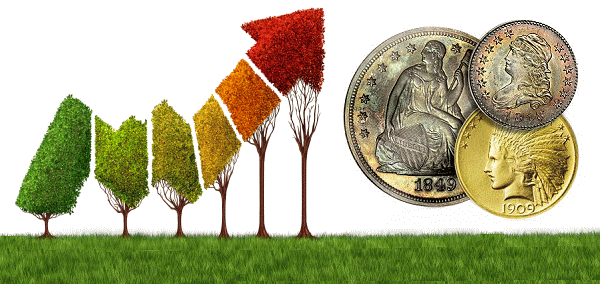
By Jeff Garrett for Numismatic Guaranty Corporation….
Due to societal changes, coin collecting has gone from a life-long pursuit to a rush to complete and sell a coin set.
Until about a decade ago, most collectors built their collections over a very long period. Many who began collecting in the 1950s, 1960s and 1970s considered numismatics to be a life-long pursuit. Over the years many great collections were formed and ultimately sold decades after they were first begun. Collectors such as Newman, Bass, Eliasberg, Ford, Pittman, Trompeter, and most recently Pogue, assembled vast collections over the course of decades. This slow process of building a collection has many advantages that should be considered.
Building a collection over a long period of time gives an individual the chance to educate themselves about what they are collecting. The absolute best way to become a successful collector is to learn about what you are collecting. It can sometimes take many years to understand the nuances of a particular series. Rushing to assemble a collection is usually a recipe for disaster, including buying the wrong coins and paying too much. Patience is a valuable trait for the successful collector. Many opportunities to purchase a great coin rarely occur and being in the game for the long-term will give collectors a better chance to make wise acquisitions.
As in life, collecting rare coins is really about relationships. This includes the experts in the field you have chosen to collect. These long term relationships can provide invaluable knowledge that has been acquired over decades in most cases. The relationships may also include fellow collectors who can explain the ropes and share inside tips for a particular series. I have spoken many times in the past about the value of mentors in numismatics. Developing these relationships generally takes time, but are well worth the investment.
Dollar cost averaging is another great benefit of collecting over a long period of time. This is especially important now with the extreme cost of many numismatic rarities. Collectors who assembled their sets in the mid to late 20th Century were able to buy coins for what now seems close to free. That is no longer the case and buying coins from many sources and over a long period helps even out purchases in a fluctuating market. If you bought a large sum of common date United States gold coins just a few years ago you would now be facing big losses. Buying smaller amounts over several years is a big help in making sure you have not bought at a market top.
Another important factor when considering holding periods for rare coins is the friction of trading too frequently. Every time you buy or sell a rare coin, someone is there to profit from the transaction. This can be quite costly if done too frequently and if you have not held your coins very long. The typical auction (buyers charge) is now around 17.5%, and even the closet margins you can expect from most dealers is 5-10%. These percentages may not seem like a lot, but they add up–just ask Heritage or Stack’s Bowers! Collecting rare coins should be done over a long period of time in my opinion. Leave day trading to the stock and commodities traders. Even those guys have a very hard time making money trading so often; the fees are hard to overcome.
An interesting study in holding rare coins for a short period was illustrated sharply in the just concluded Eugene Gardner sale in New York. The Gardner Collection was formed over a long period and Mr. Gardner adhered to most of the advice given above. I’m sure the return on his investment in numismatics paid great dividends in terms of profit, relationships and enjoyment. Mr. Gardner enjoyed collecting and was very active in many of the great sales held in the last few decades. This includes the epic sale of Eric Newman’s collection. A few of the coins that had been purchased just last year failed to reach the levels attained at the Newman sale.
This is not surprising for several reasons. Most of the coins in the Newman sale had been in his collection for more than two generations. When a great coin that has not been offered in over 75 years is sold, the bidding will be fierce. The 1861 Seated Quarter graded NGC PR 68 is a great example. Mr. Gardner and another bidder went to war to own this incredible coin. The final sales price of $188,000 was a record for the date and type that will not soon be met. In fact the coin was sold for $129,250 when it was offered a couple of weeks ago in the final installment of the Gardner Collection. This price would be considered incredible other than the fact it had sold for much more last year. I have stated many times before that the rare coin market can be psychological warfare. Having the chance to buy a coin that has been off the market for 75 years is much more exciting than buying one that has been off the market six months!
I am often asked about investing in rare coins. My standard answer is that you should not invest in rare coins, but collect them–this is almost always a great investment. This includes assembling your collection over a long period, being patient and trying to understand the series you have chosen. Too many collectors today rush to assemble a registry set, or some other sort of collection and then become bored with the hobby when it’s completed. Our society in general is now more into instant gratification and this sometimes includes coin collecting. Take time to enjoy the hobby and don’t be in a rush–the rewards will be worth the wait!
Questions about the rare coin market? Send them to [email protected].
About Jeff Garrett
 Jeff Garrett, founder of Mid-American Rare Coin Galleries, is considered one of the nation’s top experts in U.S. coinage — and knowledge lies at the foundation of Jeff’s numismatic career. With more than 35 years of experience, he is one of the top experts in numismatics. The “experts’ expert,” Jeff has personally bought and sold nearly every U.S. coin ever issued. Not a day goes by that someone doesn’t call on Jeff Garrett for numismatic advice. This includes many of the nation’s largest coin dealers, publishers, museums and institutions.
Jeff Garrett, founder of Mid-American Rare Coin Galleries, is considered one of the nation’s top experts in U.S. coinage — and knowledge lies at the foundation of Jeff’s numismatic career. With more than 35 years of experience, he is one of the top experts in numismatics. The “experts’ expert,” Jeff has personally bought and sold nearly every U.S. coin ever issued. Not a day goes by that someone doesn’t call on Jeff Garrett for numismatic advice. This includes many of the nation’s largest coin dealers, publishers, museums and institutions.
In addition to owning and operating Mid-American Rare Coin Galleries, Jeff Garrett is a major shareholder in Sarasota Rare Coin Galleries. His combined annual sales in rare coins and precious metals — between Mid-American in Kentucky and Sarasota Rare Coin Galleries in Florida — total more than $25 million.
Jeff Garrett has authored many of today’s most popular numismatic books, including Encyclopedia of U.S. Gold Coins 1795–1933: Circulating, Proof, Commemorative, and Pattern Issues; 100 Greatest U.S. Coins; and United States Coinage: A Study By Type. He is also the price editor for The Official Redbook: A Guide Book of United States Coins.
Jeff was also one of the original coin graders for the Professional Coin Grading Service (PCGS). He is today considered one of the country’s best coin graders and was the winner of the 2005 PCGS World Series of Grading. Today, he serves as a consultant to Numismatic Guaranty Corporation (NGC), the world’s largest coin grading company.
Jeff plays an important role at the Smithsonian Institution’s National Numismatic Department and serves as consultant to the museum on funding, exhibits, conservation and research. Thanks to the efforts of Jeff and many others, rare U.S. coins are once again on exhibit at the Smithsonian Institution’s Museum of American History. We urge everyone who visits Washington, D.C., to view this fabulous display.
Jeff has been a member of the prestigious Professional Numismatic Guild (PNG) since 1982 and has recently served as president of the organization. In 2009 and 2011, Jeff ran successfully for a seat on the Board of Governors for the American Numismatic Association (ANA), the leading numismatic club in the world. He plans to run for ANA vice president in 2013.





So in a nutshell, one should collect for the fun of it and not for investment. Investment is secondary or incidental. This is kind of confusing considering the deep pockets and prices higher end collectors pay. If it was all about collecting for fun, why would they spend so much money? They could just amass common dates, world coins, etc. Pride in owning rare issues is certainly a reason, but I think investment and making money or retaining it are always a part of collecting, especially for higher end folks.
you have to keep in mind that there are many times where collectors who buy rare issues lose money as well. The market is fickle. Also, many of the coins that bring big dollars at auction are genuinely rare, with a few examples known. Contrast that to a modern issue that may have thousands or millions of pieces in the wild.
I will have to disagree with Joe S. that investment and making money is an important consideration particularly with the so-called high end buyers. First and foremost, for almost all advanced and wealthy collectors, is pride in ownership and accomplishment in completing a set. Gene Gardner is a perfect and contemporary example of this kind of dedicated collector. He bought and paid dearly for coins out of very recent Eric Newman sales, knowing he had to sell his collection in the near future…and considering he might take losses. Investment and increase in value is a minor consideration with many advanced collectors.
There’s another illustration of what Jeff wrote. In the American colonial coin market – a field comprised of no speculators and with educated buyers, most of whom prefer their coins “raw”. .
I distinctly recall John Roper of Norfolk VA and Donald Groves Partrick of Long Island NY going head to head for a period of years on the great legendary colonial rarities in the 1970’s period, largely in Stack’s and Bowers & Ruddy (Merena) auctions..Partrick, younger and wealthier than Roper (yet both quite wealthy) , usually yielded to Roper when the rarities they were going head to head on got just too high.
John Roper died in his 80’s and his sale took place in Stack’s showrooms in Dec 1983 – ironically just a few days before NYC’s Doyle Galleries’ Loye Lauder (of Estee Lauder cosmetics) colonial auction which duplicated many of Roper’s coins altho in lesser quality- including (2 )1792 silver center cents.
Don Partrick, who reached his mid 80’s but decades later than Roper, ended up acquiring out of the Roper sale many colonial rarities they’d previously fought hand to hand over, for tens of thousands of dollars cheaper- ie the unique 1737 Wheele Goes Round Higley just sold in the Partrick I sale.
Can you imagine one collector actually losing tens of thousands of dollars on such a classic rarity and his competitor years later making hundreds of thousands of dollars on the same coin?
My grandmother belongs in the group that would build their collections over a very long period of time. In fact, my grandmother still have her collection! She says that she is waiting to collect a few more before handing it down to one of us. To that end, it has in fact been a life-long pursuit.